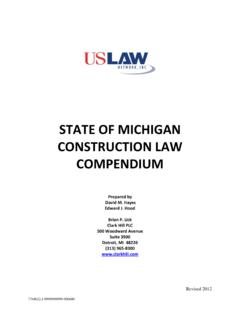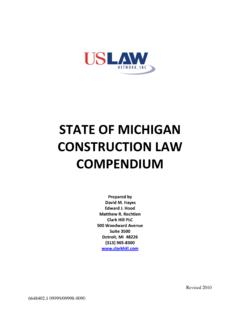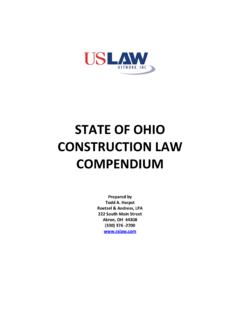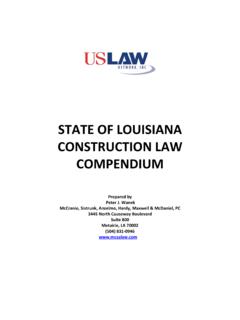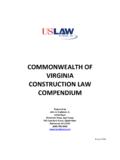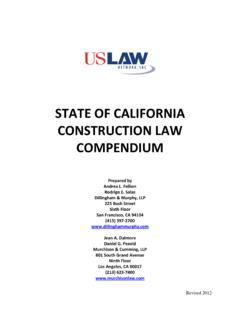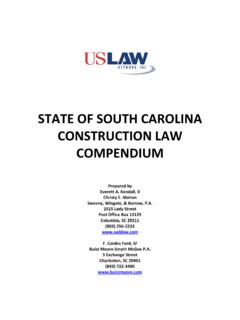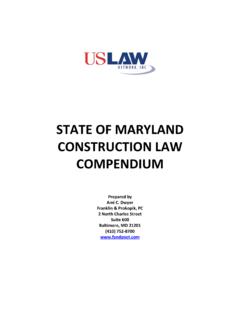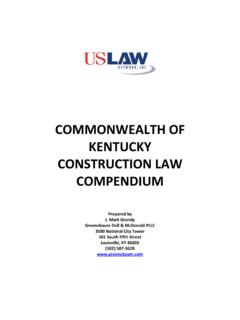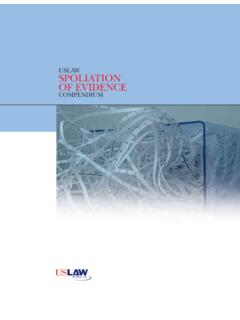Transcription of STATE OF MISSISSIPPI CONSTRUCTION LAW COMPENDIUM
1 STATE OF MISSISSIPPI CONSTRUCTION LAW COMPENDIUM Prepared by Robert P. Thompson Copeland, Cook, Taylor & Bush, 1076 Highland Colony Parkway 600 Concourse, Suite 100 Ridgeland, MS 39157 (601) 856 7200 2 MISSISSIPPI is a comparative negligence STATE . In 1910, MISSISSIPPI became the first STATE to adopt a pure form of comparative negligence in a progressive movement aimed at abolishing the harsh doctrine of contributory negligence. Act of April 16, 1910, ch. 135, 1910 Miss. Laws 125 (codified as amended at MISS. CODE ANN. 11-7-15 (Rev. 2004)); see also Coho Resources, Inc. v. Chapman, 913 So. 2d 899 (Miss. 2005) (finding MISSISSIPPI to be a pure comparative negligence STATE ). Unlike the modified system, the pure system allows a contributorily negligent plaintiff to recover even though his or her negligence exceeds that of the defendant.
2 However, the plaintiff s recovery is reduced by the proportion of negligence attributable to that particular plaintiff. Natchez & Co. v. Crawford, 55 So. 596 (Miss. 1911). As to situations with more than one (1) tortfeasor, MISSISSIPPI law imposes several liability, with an exception for those cases where one or more tortfeasors engage in a conspiracy. Miss. Code Ann. 85-5-7 provides: (2) Except as otherwise provided in subsection (4) of this section, in any civil action based on fault, the liability for damages caused by two (2) or more persons shall be several only, and not joint and several and a joint tort-feasor shall be liable only for the amount of damages allocated to him in direct proportion to his percentage of fault. In assessing percentages of fault an employer and the employer's employee or a principal and the principal's agent shall be considered as one (1) defendant when the liability of such employer or principal has been caused by the wrongful or negligent act or omission of the employee or agent.
3 * * * (4) Joint and several liability shall be imposed on all who consciously and deliberately pursue a common plan or design to commit a tortious act, or actively take part in it. Any person held jointly and severally liable under this section shall have a right of contribution from his fellow defendants acting in concert. I. Breach of Contract Typically, a breach of contract claim can be asserted by the buyer against the general contractor, as well as by the general contractor against its subcontractors. A breach of a CONSTRUCTION contract in MISSISSIPPI is subject to a six-year statute of limitations. MISS. CODE ANN. 15-1-41 (1972). The limitation period begins to run upon the occupancy or acceptance of the building or improvement by the owner-buyer.
4 McMichael v. Nu-way Steel & Supply, Inc., 563 So. 2d 1371 (Miss. 1990). However, acceptance of a subcontractor s work by a contractor is not sufficient. There must be acceptance of the work or occupancy of the building by the owner-buyer. Id. Accordingly, if acceptance and occupancy are delayed due to a dispute between contractor and owner, the contractor s liability will extend for the duration of the dispute. The MISSISSIPPI Supreme Court has acknowledged that between a contractor and owner of a new house, there is an implied warranty that the home was built in a workmanlike manner and is suitable for habitation. Parker v. Thornton, 596 So. 2d 854, 857 (Miss. 1992) (citations omitted).
5 Furthermore, [a]ccompanying every contract is a common law duty to perform with care, skill, and 3 reasonable experience, and a negligent failure to observe any of these conditions is a tort as well as a breach of contract. George B. Gilmore Co. v. Garrett, 582 So. 2d 387, 391 (Miss. 1991) (quoting Davis v. Anderson, 501 459, 462 (Tex. Civ. App. 1973)). II. Negligence Generally, an injury incurred due to negligent CONSTRUCTION may give rise to an action for breach of a contractor s common law duty to care, or negligence. An action for negligence in CONSTRUCTION could be based upon the contractor s poor workmanship, supervision, or design. To establish a claim for negligence under MISSISSIPPI law, a plaintiff must prove (1) existence of a duty on part of the defendant to conform to a specific standard of conduct, (2) breach of that duty, (3) breach of the duty was the proximate cause of the plaintiff s injury, and (4) damages to the plaintiff resulting from the breach.
6 Donald v. Amoco Prod. Co., 735 So. 2d 161 (Miss. 1999). In other words, the plaintiff must show failure to take such reasonable care as should be taken by experienced and prudent men. Daniels v. Morgan & Lindsey, Inc., 198 So. 2d 579, 585 (Miss. 1967). The plaintiff has the burden to prove liability on a claim of negligence by a preponderance of the evidence. Jones v. Jones, 760 So. 2d 828 (Miss. Ct. App. 2000). A. Duty of Care The duty of care is commonly stated as the duty that each individual owes to other people. The MISSISSIPPI Supreme Court has defined the duty of care as follows: Requisite care remains always that degree of care commensurate with appreciable danger appraised in terms of ordinary prudence and interpreted in the light of the attendant the expression and the basis of the rule remain fixed, its flexibility permits accommodation to each particular case.
7 The area of factual doubt with which juries should be allowed to function is circumscribed within a circle of which care is the axis and reasonableness is the radius. McWilliams v. City of Pascagoula, 657 So. 2d 1110, 1111 (Miss. 1995). All persons must act as a reasonable and prudent person would act under the same or similar circumstances. Hankins Lumber Co. v. Moore, 774 So. 2d 459, 464 (Miss. Ct. App. 2000). As the degree of danger increases, the required degree of care increases. Shurley v. Hoskins, 271 So. 2d 439, 444 (Miss. 1973). B. Breach of Duty Once it is established there is a duty owed by the defendant to a particular plaintiff as a matter of law, then, unless there is no material issue of fact to be decided by the fact-finder, the jury must determine if the defendant breached his duty to the plaintiff.
8 Once sufficient evidence is presented in a negligence case, even if the evidence is slight, whether a breach of duty occurred is an issue to be 4 decided by the finder of fact. Warren v. Pinnix, 241 So. 2d 662, 663 (Miss. 1970). C. Causation Causation can be one of the most difficult elements to establish and is usually a question of fact to be determined by the jury. Hankins Lumber Co., 774 So. 2d at 464-65. By the time the issue of proximate cause is relevant to liability, a breach of duty owed must already be established. It is the plaintiff s burden to prove that it is more likely than not that the breach of duty caused the injury or damages sustained. Delahoussaye v. Mary Mahoney s Inc., 783 So. 2d 666 (Miss. 2001).
9 Negligence of itself is not sufficient to permit a recovery because of injuries sustained by another. The injury must have been caused by the negligence complained of. Pargas of Taylorsville, Inc. v. Craft, 249 So. 2d 403, 406 (Miss. 1971). D. Damages The final element which must be proven by the plaintiff to prevail on a claim of negligence is that he or she suffered damage or injury as a result of the negligent conduct. Lyle v. Mladinich, 584 So. 2d 397, 399 (Miss. 1991). Without the presence of any damage or injury, a claim based on negligence must fail. Century 21 Deep South Properties, Ltd. v. Corson, 612 So. 2d 359 (Miss. 1992). In MISSISSIPPI , there is no fixed rule for determining damages. Each case must be decided on the facts and the amount of the damage award is left in large part to the discretion of the jury.
10 Kinnard v. Martin, 223 So. 2d 300, 302-03 (Miss. 1969). III. Breach of Warranty In CONSTRUCTION cases, plaintiffs typically assert causes of action for breach of warranty. A claim for breach of warranty can be based on express warranty provisions contained in the contract between the owner and the general contractor and/or warranties implied by law. MISSISSIPPI law imposes upon a contractor a duty to construct all projects in a workmanlike manner, free from defects. This warranty cannot be contracted away. MISS. CODE ANN. 11-7-18 (1994). This warranty of workmanship is implied by law into every CONSTRUCTION contract between a contractor and an owner. Keyes v. Guy Bailey Homes, Inc., 439 So. 2d 670 (Miss. 1983). Pursuant to this warranty, a contractor agrees to perform work in accordance with the degree of workmanship normally possessed by those in the CONSTRUCTION industry.
